The Mike Toole Show
Animation Appreciation
by Michael Toole,
I didn't really think hard about the “animation” part of anime until I met a guy named Koichi Tsunoda. It was at Animazement 2000, a convention that boasted an assemblage of talent from Japan that, even today, would look extremely impressive. There was director Kunihiko Ikuhara, still beating the bushes to attract more fans to his already-popular Revolutionary Girl Utena. Before he was the acclaimed animator responsible for the short cartoons in the Kill Bill films, Kazuto Nakazawa was known as the El Hazard character designer. Looking back, the most obviously intriguing figure at the convention in Raleigh had to be Hiroyuki Kitakubo, who at the time was basking in acclaim as the director of fan-favorite Golden Boy; mere months later, he'd unleash Blood: The Last Vampire. He also directed fare like Pop Chaser (one of the most remarkable-looking OVAs of the 80s! also, pornography), the first half of those 90s Jojo's Bizarre Adventure OVAs, and the fine Roujn-Z. Afterwards, like Cowboy Bebop auteur Shinichiro Watanabe did for much of the 2000s, he seemed to step out of the director's role entirely for something like a decade. That always mystified me. There were also a couple of manga artists in attendance—subdued, low-key people named Kia Asamiya and Yuu Watase. But back to Mr. Tsunoda.
At the opening ceremonies, the crowd beheld Mr. Tsunoda, a handsome older gent, who entreated the throngs of fans to let him teach them to how to actually animate big favorites like Mazinger Z and Candy Candy; when that failed to yield a big enough round of applause, he hastily added Dragonball to the list, which got the reaction he was looking for. Tsunoda returned to Animazement a number of times over the years; using markers and large flipbooks, he'd walk a classroom of fans through the creation of simple motion in an animated sequence; a walk cycle here, a thrown punch there. Tsunoda was a good artist, but his drawings for these classes were simple, workmanlike, and sometimes a bit sloppy. The lesson was obvious: you didn't have to be a machine-precise draftsman to be an animator, you just had to be ready to work hard and make an awful lot of corrections as you went along.

I've had animation on the brain for months now. It's because of a whole bunch of reasons—meeting some talented animators earlier in the year, witnessing the premiere of Masaaki Yuasa and company's delightful Kick-Heart, and more recently, Space Dandy. You've probably got an eye on Space Dandy, right? It's been heralded as a sort of return to form for part of the old Cowboy Bebop band, and in a lot of ways, it delivers—it's weird, colorful, funny, and an absolute goddamn animator's playground. Director Watanabe has actually taken a novel approach this time around—unlike in his earlier shows, he plays the role of sou kantoku, or general director, for Space Dandy. The director is actually Shingo Natsume; he's the guy who has to keep the project humming along on schedule, and much of his artistic duties involve not editing the story or drawing or correcting animation frames but watching and correcting the storyboards, in order to catch artistic and continuity issues before they can even bubble to the surface. Watanabe did that dance for Cowboy Bebop and Kids on the Slope, but for Dandy he makes broad creative decisions (he's pitched in some scripts, as well) and lets the team run wild. Some have wryly speculated that his biggest duty in Space Dandy is hanging out and preparing his next project as much as possible!
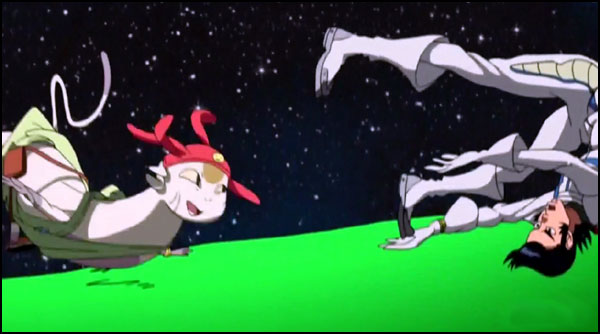
But Watanabe's taken a novel and really awesome approach to putting this series together. Every episode has new key creative staff—each one boasts a different director, some pretty famous (Michiko & Hatchin's Sayo Yamamoto, Steins;gate's Hiroshi Hamasaki) and some more renowned for strict technical skills (So Toyama, Michio Mihara). In that way, despite the fact that Watanabe's steering the ship, every episode's a little different.
The reason I've been thinking about the technical side of Dandy so much is the sheer accessibility of its production data to English-speaking dorks like myself. Typically with simulcasts, much of the production credits are left untranslated, but Space Dandy's details are splashed all over the ending sequence in English every week. This is also the first show that's boasted creative staff like Thomas Romain and Kevin Aymeric tweeting to fans in English and French, week-to-week, about upcoming episode details; a surprised Akemi Hayashi even reached out to English-speaking fans after her episode drew praise. If you can read Japanese easily (I sure as hell can't!) you'll learn even more; while Space Dandy’s recently-announced second season was kind of a foregone conclusion, Japanese-speaking fans who follow the animation staff on social media knew about it before the rest of us. One crucial stop: Ben Ettinger's AniPages, which has been carefully breaking down the technical details of every Dandy episode.
So that's one reason why I'm enjoying Space Dandy. Another big reason is also tied to social media—it's the way the show's been rolled out, almost totally worldwide, day-and-date. At Otakon Vegas, Funimation were quick to point out that Space Dandy is the first-ever anime to debut before the Japanese release, and while this isn't true (Marine Boy, Royal Space Force, and Ghost in the Shell all hit the airwaves/screen here first, and I'm sure there are others) Space Dandy is the first anime TV series to roll out globally, starting in the US, in the age of social media. There's a huge contrast between watching this show and 2009's Kurokami: The Animation, which aired on the now-defunct ImaginAsian network the same day of its Japanese release. It was a neat phenomenon, and Kurokami is tons of fun, but it just didn't have the insane buzz that Space Dandy does.
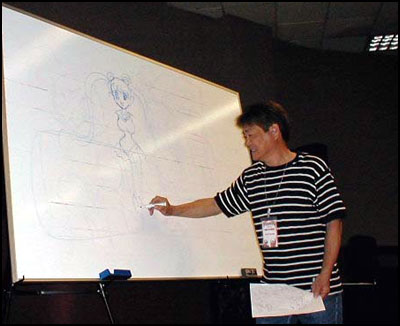
To get back to the big animation talk, what Koichi Tsunoda, who sadly passed away in January, taught me about anime is that learning how it's produced and meeting the people who create it make for a richer experience overall. A highlight of last year's AnimeNext convention was witnessing the director Sayo Yamaoto and her Fujiko Mine key animator Hiroshi Shimizu at work. Working just from imagination, Yamamoto rapidly filled in storyboard sheets, while Shimizu watched carefully and started to create frames based on the boards. He made a lot fewer mistakes than Tsunoda did! In 2012, I spoke with of the production managers for Gundam Unicorn, a man who appeared to be about my age. I asked him what it was like to make the jump from ink and paint to digital, and he smiled shyly and said he'd used digital tools his entire career; the shift had started even earlier than I'd thought. I'm not much use at writing fiction and I certainly can't draw, so learning details like this helps me feel closer to the animation.
More than anything, these experiences make me feel kinda dumb for not zeroing in on this aspect of anime sooner. When I first became a fan, I started to learn the names of famous directors like Miyazaki and Oshii, because those are the people most responsible for a show being good or bad, right? From there, I spent time mooning over my favorite character and mecha designers, and then seiyuu. All this time, I was being quietly passed in the convention halls by folks like Noboru Ishiguro and Takeshi Honda, prodigious talents with huge resumes who just didn't seem that flashy. One convention sticks out in particular—Katsucon 1997, my second. I somehow managed to ignore Kazuo Yamazaki, who'd directed the Five Star Stories movie, already a favorite of mine at the time. I tried to sit still for Ranma ½ animator Shinji Takagi's panel, but he was a quiet dude and there were only eight of us in the room. I've been far luckier in recent years, having gotten to meet both Mamoru Hosoda and Makoto Shinkai not once but twice, but if you visit conventions, lectures, or screenings with the people who make this stuff, don't pass up the chance to hear them speak! Even if they speak a little quietly.
I thought this column was gonna be a short one, but then this suddenly appeared in my mailbox.
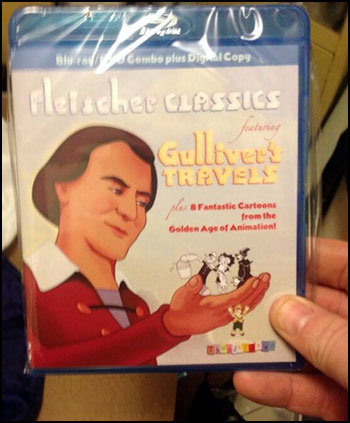
“Ha,” you're saying, “that's a crummy ol’ American cartoon movie! What does that have to do with anime?” Well, Max Fleischer's Gulliver's Travels does happen to be an amusingly obvious influence on one of my all-time favorite anime movies.
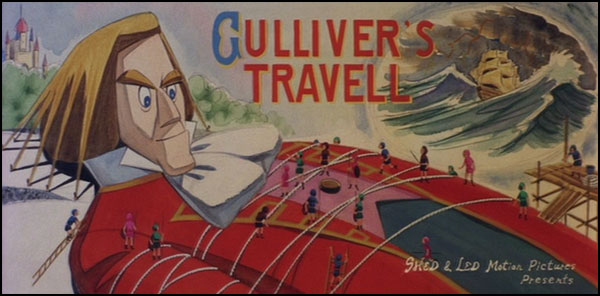
That frame's right out of the beginning of Gulliver's Travels Beyond the Moon! I guess Gulliver is Gulliver, whether he's on his Travels or he's going Beyond the Moon, or both. I like how he's wearing the Dreamworks Smirk in that poster, though. The thing is, until I sat down to enjoy this new blu-ray, meticulously restored by cartoon historian Steve Stanchfield, I'd never taken note of just how much the 1939 American film had influenced the 1966 Japanese one.
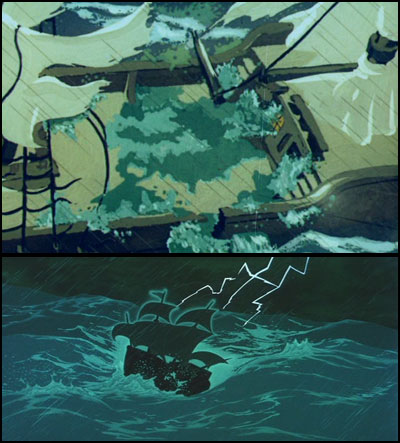
See, during World War II, there was a ban on foreign media in Japan, so they didn't get all of the swell theatrical cartoons of the time period. Once the war was over and the embargo was lifted, it was obviously time to open the floodgates and get the Japanese public caught up on all of those great Disney movies of the 30s and 40s! Except that, as it turns out, the first foreign cartoon film out of the gate in 1948 was Gulliver's Travels. I find it fascinating that, almost 20 years later, it would have such an obvious influence on a cartoon made in Japan. But hang on a second—what's this?

The lower frame is Gulliver's Great Activities, a 1950 cartoon short that was actually produced by Japan's National Tax Agency. The idea was simple—when a mysterious giant is washed ashore, the tiny denizens of the land fret about feeding and caring for their big friend—they can't afford such an expense! But by pooling their resources and paying the tax, “Gulliver” is fed and cleaned up, and immediately sets to work building public facilities, helping with disaster relief, and driving foreign trade. Yep, that's a tax propaganda cartoon, alright. The short is rough around the edges, but it unmistakably and cheekily swipes a whole bunch of imagery from Gulliver's Travels.
I marveled earlier about Gulliver's Travels Beyond the Moon still showing its roots despite being made 18 years later, but the fact is, it probably couldn't have been made any sooner. All those successful, flashy Disney films did an amazing job keeping domestic animation projects from being greenlit, but by 1958, the supply had dried up. By an astonishing coincidence, Toei started releasing animated films in 1958. The idea of Japanese animated films having to compete (or not) with technically savvier Disney fare never occurred to me. I just figured Toei didn't have their shit together until then!
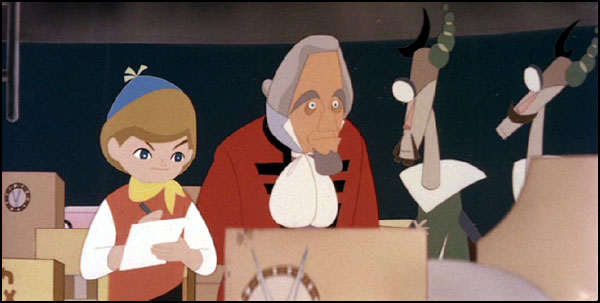
I still find it hard to describe Gulliver's Travels Beyond the Moon. It looks almost wholly unlike any anime film before or after it; if I had to make a comparison, I'd say it's animated in Little Golden Book-o-vision. Its undeniably quirky story (a street urchin takes up with Gulliver himself, along with a talking dog and tin toy soldier, on a trip to battle an oppressive robot army in space) is augmented by great music and songs (just like Fleischer's Gulliver, this film is packed with music—though it's not quite an operetta, which Gulliver's Travels definitely is) by Isao “Kimba the White Lion” Tomita or Milton “The Gong Show” (yes, really) DeLugg, depending on whether you watch it in Japanese or English. It's got unusual stunt casting in both dubs, as well—street urchin Ted is played by pop crooner Kyu Sakamoto in Japanese (his #1 US hit “Sukiyaki” can be heard in From Up on Poppy Hill, incidentally), while the film's alien robot princess is played by Darla Hood, who was Darla in those old Our Gang/The Little Rascals shorts. Hayao Miyazaki served not just as an animator; he made key suggestions to help improve the film's story. It's a marvelous little movie, and I'm bummed out that there's still not yet an official, high-quality DVD release.
I dropped some Gulliver knowledge in the above paragraphs, but that doesn't mean that I'm a smart, cool guy. I just learn awesome stuff from books like Anime: A History, Jonathan Clements’ new academic tome that examines Japanese animation not just as great artwork and pop culture, but as modern industrial product, created and developed by dozens or hundreds at a time to be enjoyed by millions. I got the date of Gulliver's Travels’ release from there, as well as some data on Gulliver's Great Activities and delightful information on Beyond the Moon's creative staff. For instance, key animator Yasuo Otsuka describes the period as a time of explosive growth in the anime business, with “anime headhunters” lined up to steal talent like agents competing for idol singers; Yasuji Mori, another animation legend, remembers producer Hiroshi Okawa as a burly, intimidating, ill-tempered man who nevertheless always exhibited excitement for Toei's animation potential. Even about one of my favorite films, I still learn more from this book. It's a good one.
This column's kinda wandered around a bit, hasn't it? We started with a mind-expanding experience with a great old animator, talked some Space Dandy, and then took a trip to several different versions of Lilliput. All of these things just make me excited for more anime. While Space Dandy's gonna be on vacation for the summer, it looks like we might be getting a great fill-in in Masaaki Yuasa's Ping Pong. In the meantime, you can catch me in two weeks at Anime Boston, doing my usual Dubs that Time Forgot/Anime Hell circuit. If you take anything away from this little screed, let it be this: whether it's a global hit like Space Dandy or a classic influencer like Gulliver's Travels, animation isn't merely a tool for imaginative storytelling, but a restless, breathtaking, and amazing canvas on its own. If you're not paying close attention to it, you may not know what you're missing, so please find out soon!
discuss this in the forum (34 posts) |